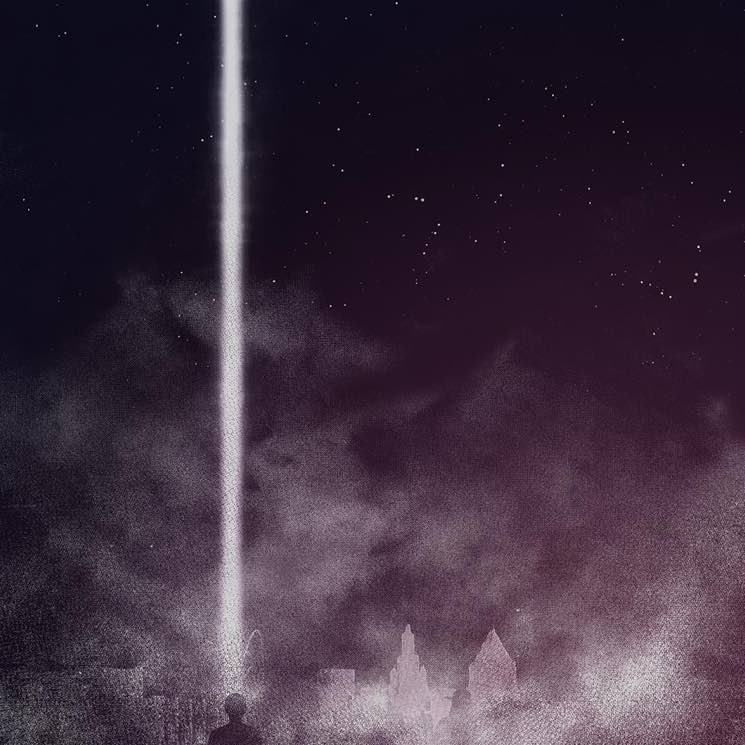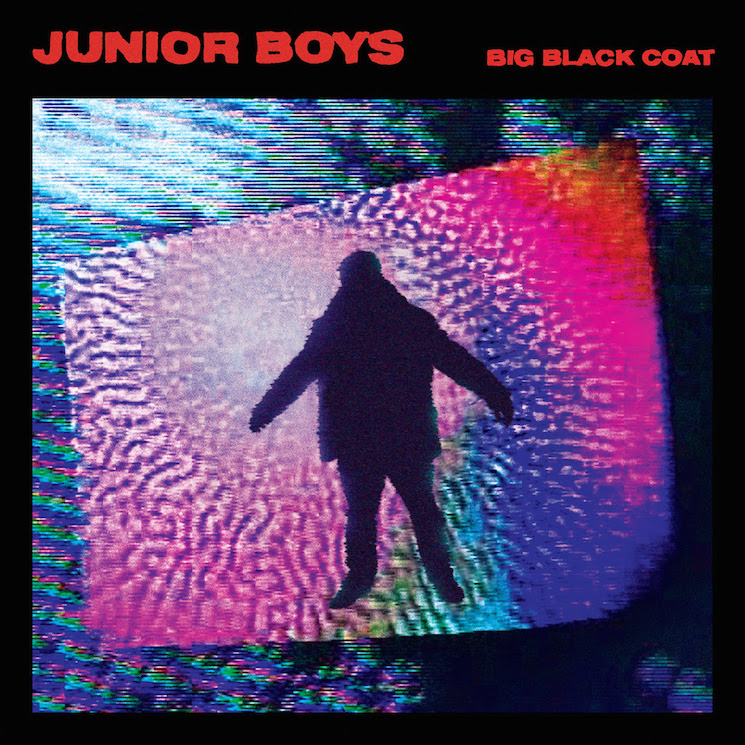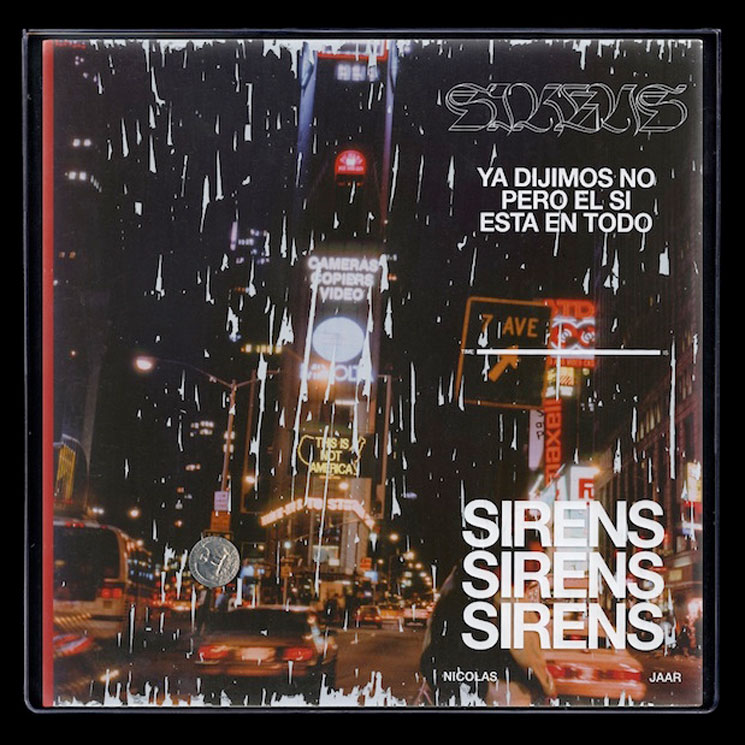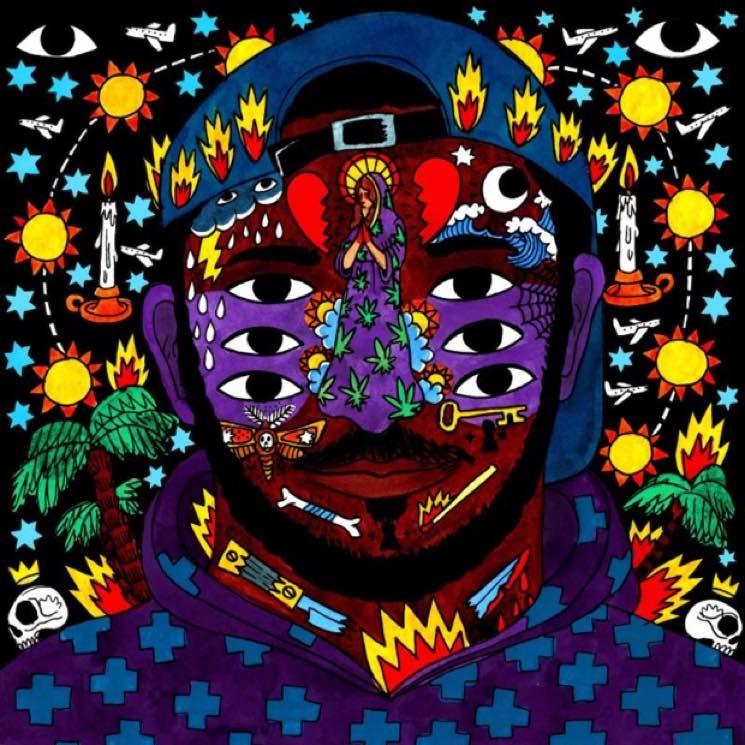Our Best of 2016 albums lists by genre continue today with our staff picks for the 10 best electronic albums this year.
Click next to read through the albums one by one, or use the list below to skip ahead to your favourites.
Top 10 Dance & Electronic Albums of 2016:

10. Tycho
Epoch
(Ghostly International)
Scott Hansen, Tycho's prime architect, cleverly called his band's final album in a trilogy Epoch; it's defined as a period of time characterized by a distinctive development or by a memorable series of events. Since 2011's Dive and 2014's Awake, Tycho has organically evolved from a tranquil solo electronic project into a dynamic three-piece live band while tightening up the group's signature lush mosaic of meticulous and potent instrumental melodies.
Epoch's strength is its balance between restraint and attack. The band know when to carefully hold back, building up a pleasantly blissful ambience on tracks like "Receiver" or "Continuum," and when to shift gears to an upbeat approach, such as on the title track or the prismatic "Horizon." Like Tycho's previous work, Epoch evokes a nostalgic and exuberant dream-like environment, tastefully crafted by colourful synthesizers and crisp guitar riffs, punctuated by striding percussion. Epoch is the pinnacle of Tycho's analog-electronic brilliance.
Chris Gee

9. The Range
Potential
(Domino)
Sampling found sound is certainly nothing new in electronic music, but by scouring the margins of YouTube for new, fascinating and affecting voices, Pennsylvania DJ and producer James Hinton, better known as the Range, made it feel new and exciting again, weaving a sonic tapestry as human as it is technically brilliant.
On opener "Regular," for example, Hinton marries a chopped-up plea by a young musician to a sparse, chiming two-step beat that's as tense as it is hopeful, imbuing the voice with added emotion; on the propulsive "Five Four," a rapper confronts the traumatic effects of day-to-day oppression as Hinton propels it all with a hard, sky-reaching piano loop. Like the best electronic music, Potential has the ability to move both the dance floor and the mind, and from the album's beginning all the way to closer "1804," that's exactly what the Range does here.
Stephen Carlick

8. Junior Boys
Big Black Coat
(City Slang)
In the world of electronic music, a lot can change in five years. Unattached to any real trends over their career, Hamilton's Junior Boys were able to use the time since 2011's It's All True to reinvigorate their perspective and come back with a renewed sense of purpose. Shifting past the fragile, introspective electro-pop framework that served them well in the past, the duo's Big Black Coat is obviously a result of time away from the project, influenced by the late-night club culture that both frontman Jeremy Greenspan and Matt Didemus have been dabbling in as DJs, during different parts of their career.
The duo have boldly embraced Detroit techno, Krautrock, early electro and maybe even some Prince on their fifth album, but they haven't abandoned the themes of love and longing typically found in Greenspan's lyrics. Big Black Coat's sleek, emotive take on techno feels both vulnerable and confident at times, allowing Junior Boys to reference elements of the past while opening the door to the future.
Anthony Augustine

7. Tim Hecker
Love Streams
(Paper Bag)
By going spacier and more ambient than his last record, 2013's Virgins, Tim Hecker's masterful Love Streams provides a satisfying breath of air following the minimalist ambient composer's previous three releases, all of which were hailed as some of the best electronic albums since the turn of the century.
As with the best ambient music, Love Streams is a series of tracks that could be listened to while performing other tasks — working, driving, meditating — or with the listener's full, undivided attention. The symphony of vocal effects and keyboards here produce otherworldly and alien-like melodies that are the benchmarks of Hecker's style, but they mark a departure from his recent work, with less of an overwhelming sense of misery and a more relaxed tone. This, combined with its relative brevity, makes Love Streams feel like something like a break from his more intense compositions, but it says something about an artist when even a break sounds as beautiful this.
Adam Nizam

6. Gold Panda
Good Luck and Do Your Best
(City Slang)
Gold Panda is one of those artists you never really get a bad draw with (see 2013's Half of Where You Live, 2010's Lucky Shiner). He's also an artist who, time and again, lives up to stellar prior releases in every capacity, putting new spins on his now-trademark style.
In an era where electronic music could use a bit of polish and a push in a new direction, the UK producer's third LP, Good Luck and Do Your Best — inspired by a trip to Japan and the parting words of a friendly taxi driver — stands refreshingly on its own. It's the understated surprises that make this album special: the chimes and occasional subtle blast of horn intertwining on "Halyards"; the cheeky scale-back and slight rewind nearing the end of "Chiba Nights"; the unexpected reflective, almost mournful tone of "Unthank." Good Luck and Do Your Best epitomizes in name what it does in practice — no luck required.
Ashley Hampson

5. Nicolas Jaar
Sirens
(Other People)
Much of the press around Nicolas Jaar's incredible sophomore LP Sirens has focused on the record's politics, the way Jaar's anguished lyrics wrestle with Chilean history and today's global politics of fear. But to reduce this record to its real-world inspiration or its political intentions, even if Jaar himself acknowledges them, is to lose sight of the awesome grandeur of the music itself.
Sirens is cinematic in scope, and carefully paced in a way that rewards listening to its entirety. It's adventurous in its embrace of varied styles and timbres, but delivers them with a consistent feeling of grittiness, raw sincerity and depth.
The arresting piano and shattered glass intro of "Killing Time," the avant-jazz saxophone solo in "The Governor," the propulsive post-punk beat in "Three Sides of Nazareth" and the plaintive piano scattered throughout the album are likely highlights for many listeners, but Sirens possesses a feeling of immensity that makes cherry-picking for highlights like these seem counterproductive. It's better to just listen from the beginning, and be transported by this stirring and evocative work.
Will Pearson

4. Jessy Lanza
Oh No
(Hyperdub)
Expectations were high for Canadian Jessy Lanza's sophomore Hyperdub outing. Pull My Hair Back from 2013 put the jazz-trained, R&B-loving vocalist in the spotlight seemingly overnight, her subdued, effortlessly charming vocals and '80s-inflected production earning her instant fans and accolades. Luckily, when Oh No dropped in May, it was just as good, if not better than her impressive debut, pairing well-honed pop sensibilities with a willingness to get weird when appropriate.
As before, Jeremy Greenspan of Junior Boys lends his talents to the mix, and he and Lanza prove a winning combination once again. The production is more sure-footed this time around, the tempos quicker, and Lanza's vocals more playful, cooing breathily one second and admonishing dismissively the next. The minimalist production matches this energy, holding steady for a hooky chorus as readily as pursuing an oddball tangent for 45 seconds. It's an album full of personality, and Lanza pulls it off winningly, building on her strengths as well as broadening her horizons on this huge step forward.
Luke Pearson

3. The Avalanches
Wildflower
(XL)
What makes the Avalanches' Wildflower — the forever-in-the-making follow-up to the Australian turntablists' 2000 masterpiece, Since I Left You — such a fascinating listen is the bonkers way they approach the album's samples, themes and collaborators. While many successful electronic artists have used their stature to indiscriminately bring in the biggest guests they can land, the Avalanches dug deep into their contact list, working with artists that best suited the album's warped vision, from Biz Markie to Toro Y Moi, MF DOOM to Royal Trux's Jennifer Herrema — hell, they even managed to pull David Berman out of retirement.
The samples used on this 21-track LP are bursting with just as much personality as those on their debut: the goofy "Frankie Sinatra," for example, is a masterfully stitched earworm that benefited from eternal patience and foresight in clearing both Rodgers and Hammerstein and the Beatles. If Wildflower is what 16 years of hard work gets you, then 2032 should be a good year for quirky electronic music.
Daniel Sylvester

2. A Tribe Called Red
We Are the Halluci Nation
(Pirates Blend)
In a year when Canadians had to confront their own ignorance about our country's deplorable damage to First Nations families and their heritage, A Tribe Called Red made a record that was impossible to ignore.
There were federal acknowledgements and apologies, truths, reconciliations, revelations and exhortations for a bright future to emerge from a grim past. These things came from all over the cultural and political spectrum, and We Are the Halluci Nation reflected this complex, conscious, emotional tapestry.
Ostensibly electronic music, nothing about this record could be relegated to the background. The sound is almost always raging fire, burning everything in its path, and its path is narrated by guests like Yasiin Bey, Black Bear, Joseph Boyden, Tanya Tagaq, Lido Pimienta, Saul Williams, John Trudell and Shad, among other comrades in arms. There's some pacing in its racing, but even its quieter, spoken word interludes are hauntingly heavy. We Are the Halluci Nation is a big, big noise that needed to be heard.
Vish Khanna

1. Kaytranada
99.9%
(XL)
While Montreal is far from lacking great musical exports, it's no exaggeration when we say it needed Kaytranada. Scratch that, Canada needed Kaytranada. Most of the artists that have managed to make a name for themselves outside our great nation have been overwhelmingly white. And straight.
Enter Kaytra. Haitian-Québécois, gay and seamlessly bridging the gap between electronica, R&B, pop and hip-hop. Opening for Madonna. Working with Chance the Rapper, Katy B and Anderson .Paak. And then he goes and drops 99.9%, winner of the Polaris Music Prize and arguably the best album of the year, all while managing to get AlunaGeorge, Craig David, Vic Mensa, Little Dragon and many others to feature. It's an album that finally made people realize what all his fans that have been following him wherever he spins have known forever — that Kaytranada can do it all, and do it well.
A humble king making bouncy and danceable tracks that garner critical acclaim and kudos from industry veterans, Kaytranada finally broke the idea that the only great music from Montreal is gloomy, impenetrable, post-something or artsy with a capital A. That it's accessible to all is just icing on 99.9%'s rich cake.
Scott Simpson
Click next to read through the albums one by one, or use the list below to skip ahead to your favourites.
Top 10 Dance & Electronic Albums of 2016:
- 10. Tycho - Epoch
- 9. The Range - Potential
- 8. Junior Boys - Big Black Coat
- 7. Tim Hecker - Love Streams
- 6. Gold Panda - Good Luck and Do Your Best
- 5. Nicolas Jaar - Sirens
- 4. Jessy Lanza - Oh No
- 3. The Avalanches - Wildflower
- 2. A Tribe Called Red - We Are the Halluci Nation
- 1. Kaytranada - 99.9%

10. Tycho
Epoch
(Ghostly International)
Scott Hansen, Tycho's prime architect, cleverly called his band's final album in a trilogy Epoch; it's defined as a period of time characterized by a distinctive development or by a memorable series of events. Since 2011's Dive and 2014's Awake, Tycho has organically evolved from a tranquil solo electronic project into a dynamic three-piece live band while tightening up the group's signature lush mosaic of meticulous and potent instrumental melodies.
Epoch's strength is its balance between restraint and attack. The band know when to carefully hold back, building up a pleasantly blissful ambience on tracks like "Receiver" or "Continuum," and when to shift gears to an upbeat approach, such as on the title track or the prismatic "Horizon." Like Tycho's previous work, Epoch evokes a nostalgic and exuberant dream-like environment, tastefully crafted by colourful synthesizers and crisp guitar riffs, punctuated by striding percussion. Epoch is the pinnacle of Tycho's analog-electronic brilliance.
Chris Gee

9. The Range
Potential
(Domino)
Sampling found sound is certainly nothing new in electronic music, but by scouring the margins of YouTube for new, fascinating and affecting voices, Pennsylvania DJ and producer James Hinton, better known as the Range, made it feel new and exciting again, weaving a sonic tapestry as human as it is technically brilliant.
On opener "Regular," for example, Hinton marries a chopped-up plea by a young musician to a sparse, chiming two-step beat that's as tense as it is hopeful, imbuing the voice with added emotion; on the propulsive "Five Four," a rapper confronts the traumatic effects of day-to-day oppression as Hinton propels it all with a hard, sky-reaching piano loop. Like the best electronic music, Potential has the ability to move both the dance floor and the mind, and from the album's beginning all the way to closer "1804," that's exactly what the Range does here.
Stephen Carlick

8. Junior Boys
Big Black Coat
(City Slang)
In the world of electronic music, a lot can change in five years. Unattached to any real trends over their career, Hamilton's Junior Boys were able to use the time since 2011's It's All True to reinvigorate their perspective and come back with a renewed sense of purpose. Shifting past the fragile, introspective electro-pop framework that served them well in the past, the duo's Big Black Coat is obviously a result of time away from the project, influenced by the late-night club culture that both frontman Jeremy Greenspan and Matt Didemus have been dabbling in as DJs, during different parts of their career.
The duo have boldly embraced Detroit techno, Krautrock, early electro and maybe even some Prince on their fifth album, but they haven't abandoned the themes of love and longing typically found in Greenspan's lyrics. Big Black Coat's sleek, emotive take on techno feels both vulnerable and confident at times, allowing Junior Boys to reference elements of the past while opening the door to the future.
Anthony Augustine

7. Tim Hecker
Love Streams
(Paper Bag)
By going spacier and more ambient than his last record, 2013's Virgins, Tim Hecker's masterful Love Streams provides a satisfying breath of air following the minimalist ambient composer's previous three releases, all of which were hailed as some of the best electronic albums since the turn of the century.
As with the best ambient music, Love Streams is a series of tracks that could be listened to while performing other tasks — working, driving, meditating — or with the listener's full, undivided attention. The symphony of vocal effects and keyboards here produce otherworldly and alien-like melodies that are the benchmarks of Hecker's style, but they mark a departure from his recent work, with less of an overwhelming sense of misery and a more relaxed tone. This, combined with its relative brevity, makes Love Streams feel like something like a break from his more intense compositions, but it says something about an artist when even a break sounds as beautiful this.
Adam Nizam

6. Gold Panda
Good Luck and Do Your Best
(City Slang)
Gold Panda is one of those artists you never really get a bad draw with (see 2013's Half of Where You Live, 2010's Lucky Shiner). He's also an artist who, time and again, lives up to stellar prior releases in every capacity, putting new spins on his now-trademark style.
In an era where electronic music could use a bit of polish and a push in a new direction, the UK producer's third LP, Good Luck and Do Your Best — inspired by a trip to Japan and the parting words of a friendly taxi driver — stands refreshingly on its own. It's the understated surprises that make this album special: the chimes and occasional subtle blast of horn intertwining on "Halyards"; the cheeky scale-back and slight rewind nearing the end of "Chiba Nights"; the unexpected reflective, almost mournful tone of "Unthank." Good Luck and Do Your Best epitomizes in name what it does in practice — no luck required.
Ashley Hampson

5. Nicolas Jaar
Sirens
(Other People)
Much of the press around Nicolas Jaar's incredible sophomore LP Sirens has focused on the record's politics, the way Jaar's anguished lyrics wrestle with Chilean history and today's global politics of fear. But to reduce this record to its real-world inspiration or its political intentions, even if Jaar himself acknowledges them, is to lose sight of the awesome grandeur of the music itself.
Sirens is cinematic in scope, and carefully paced in a way that rewards listening to its entirety. It's adventurous in its embrace of varied styles and timbres, but delivers them with a consistent feeling of grittiness, raw sincerity and depth.
The arresting piano and shattered glass intro of "Killing Time," the avant-jazz saxophone solo in "The Governor," the propulsive post-punk beat in "Three Sides of Nazareth" and the plaintive piano scattered throughout the album are likely highlights for many listeners, but Sirens possesses a feeling of immensity that makes cherry-picking for highlights like these seem counterproductive. It's better to just listen from the beginning, and be transported by this stirring and evocative work.
Will Pearson

4. Jessy Lanza
Oh No
(Hyperdub)
Expectations were high for Canadian Jessy Lanza's sophomore Hyperdub outing. Pull My Hair Back from 2013 put the jazz-trained, R&B-loving vocalist in the spotlight seemingly overnight, her subdued, effortlessly charming vocals and '80s-inflected production earning her instant fans and accolades. Luckily, when Oh No dropped in May, it was just as good, if not better than her impressive debut, pairing well-honed pop sensibilities with a willingness to get weird when appropriate.
As before, Jeremy Greenspan of Junior Boys lends his talents to the mix, and he and Lanza prove a winning combination once again. The production is more sure-footed this time around, the tempos quicker, and Lanza's vocals more playful, cooing breathily one second and admonishing dismissively the next. The minimalist production matches this energy, holding steady for a hooky chorus as readily as pursuing an oddball tangent for 45 seconds. It's an album full of personality, and Lanza pulls it off winningly, building on her strengths as well as broadening her horizons on this huge step forward.
Luke Pearson

3. The Avalanches
Wildflower
(XL)
What makes the Avalanches' Wildflower — the forever-in-the-making follow-up to the Australian turntablists' 2000 masterpiece, Since I Left You — such a fascinating listen is the bonkers way they approach the album's samples, themes and collaborators. While many successful electronic artists have used their stature to indiscriminately bring in the biggest guests they can land, the Avalanches dug deep into their contact list, working with artists that best suited the album's warped vision, from Biz Markie to Toro Y Moi, MF DOOM to Royal Trux's Jennifer Herrema — hell, they even managed to pull David Berman out of retirement.
The samples used on this 21-track LP are bursting with just as much personality as those on their debut: the goofy "Frankie Sinatra," for example, is a masterfully stitched earworm that benefited from eternal patience and foresight in clearing both Rodgers and Hammerstein and the Beatles. If Wildflower is what 16 years of hard work gets you, then 2032 should be a good year for quirky electronic music.
Daniel Sylvester

2. A Tribe Called Red
We Are the Halluci Nation
(Pirates Blend)
In a year when Canadians had to confront their own ignorance about our country's deplorable damage to First Nations families and their heritage, A Tribe Called Red made a record that was impossible to ignore.
There were federal acknowledgements and apologies, truths, reconciliations, revelations and exhortations for a bright future to emerge from a grim past. These things came from all over the cultural and political spectrum, and We Are the Halluci Nation reflected this complex, conscious, emotional tapestry.
Ostensibly electronic music, nothing about this record could be relegated to the background. The sound is almost always raging fire, burning everything in its path, and its path is narrated by guests like Yasiin Bey, Black Bear, Joseph Boyden, Tanya Tagaq, Lido Pimienta, Saul Williams, John Trudell and Shad, among other comrades in arms. There's some pacing in its racing, but even its quieter, spoken word interludes are hauntingly heavy. We Are the Halluci Nation is a big, big noise that needed to be heard.
Vish Khanna

1. Kaytranada
99.9%
(XL)
While Montreal is far from lacking great musical exports, it's no exaggeration when we say it needed Kaytranada. Scratch that, Canada needed Kaytranada. Most of the artists that have managed to make a name for themselves outside our great nation have been overwhelmingly white. And straight.
Enter Kaytra. Haitian-Québécois, gay and seamlessly bridging the gap between electronica, R&B, pop and hip-hop. Opening for Madonna. Working with Chance the Rapper, Katy B and Anderson .Paak. And then he goes and drops 99.9%, winner of the Polaris Music Prize and arguably the best album of the year, all while managing to get AlunaGeorge, Craig David, Vic Mensa, Little Dragon and many others to feature. It's an album that finally made people realize what all his fans that have been following him wherever he spins have known forever — that Kaytranada can do it all, and do it well.
A humble king making bouncy and danceable tracks that garner critical acclaim and kudos from industry veterans, Kaytranada finally broke the idea that the only great music from Montreal is gloomy, impenetrable, post-something or artsy with a capital A. That it's accessible to all is just icing on 99.9%'s rich cake.
Scott Simpson
